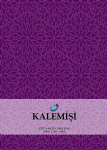TÜRK ÇİNİ VE SERAMİKLERİNDE KULLANILAN HAYVAN FİGÜRLERİ VE GİYSİ TASARIMINA YANSITILMASI
ANIMAL PATTERNS USED ON THE TURKISH TILE AND CERAMICS AND THEIR REFLECTION ON CLOTHING DESIGN
Author(s): Nuran OcakoğluSubject(s): Museology & Heritage Studies, Customs / Folklore, Visual Arts, The Ottoman Empire
Published by: Sanat ve Dil Araştırmaları Enstitüsü
Keywords: Tile; Ceramics; Clothing; Design;
Summary/Abstract: It is known that the origin of Turkish tile and ceramic art, which has a very important place in traditional Turkish arts, dates back to Central Asia. Turkish tile and ceramic art, which showed its greatest development in Anatolia, started with the Anatolian Seljuks. Developing over the centuries, this art experienced its golden age in Ottoman times with its unique aesthetic values. The source of the motifs used in the Turkish tile art dates back to the Turkish tribes living in Asia. Animal figures have always been an important decoration element in Turks who are originally from the steppe culture. Although the animal figure which was seen in Seljuk period tiles and ceramics decreased due to the influence of Islam in the Ottoman period, it has been artfully painted within this branch of art from past to present. In this study, animal figures used in Turkish tile and ceramic art from past to present have been studied and these motifs are intended to be reflected in contemporary women's clothing. It is important to give different usage characteristics to these patterns within modern life for the preservation of Turkish tile and ceramic patterns which is one of our important cultural heritage.
Journal: Kalemişi - Türk Sanatları Dergisi
- Issue Year: 6/2018
- Issue No: 13
- Page Range: 409-425
- Page Count: 17
- Language: Turkish

